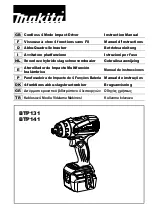
PDSSAP 20-Li B3
GB
│
IE
│
9
■
■
Use a dry cloth to clean the housing. Never use
petrol, solvents or cleansers which can damage
plastic.
■
If a lithium-ion battery is to be stored for an
extended period, the charge level should be
checked regularly. The optimum charge level is
between 50% and 80%. The optimum storage
environment is cool and dry.
NOTE
►
Spare parts which are not listed (e.g. carbon
brushes, switches) can be ordered via our
Service Hotline.
Disposal
The product and packaging are recyclable. They
are subject to extended producer responsibility and
are collected separately.
Do not dispose of power tools
in your normal domestic waste!
The adjacent symbol of a crossed-out
dustbin means that this appliance is
subject to Directive 2012/19/EU. This directive
states that this appliance may not be disposed of in
the normal household waste at the end of its useful
life, but must be taken to specially set-up collection
locations, recycling depots or disposal companies.
The disposal is free of charge for the user.
Protect the environment and dispose of this
appliance properly.
If your old appliance has stored any personal data,
you are responsible for deleting it yourself before
returning it.
If it is possible to do so without destroying the old
appliance, remove the old batteries or rechargea-
ble batteries before returning the appliance for
disposal and take them to a separate collection
point. In the case of permanently installed
rechargeable batteries, you must indicate during
disposal that the appliance contains a battery.
Your local community or municipal
authorities can provide information on
how to dispose of the worn-out product.
Do not dispose of batteries in
your normal household waste!
Defective or worn-out rechargeable
batteries must be recycled according to
Directive 2006/66/EC. Batteries/rechargeable
batteries must be treated as hazardous waste and
must therefore be disposed of in an environmentally
sound manner by appropriate bodies (dealers,
specialist dealers, public municipal bodies, com-
mercial disposal companies). Batteries/recharge-
able batteries may contain toxic heavy metals.
For this reason, do not dispose of batteries/
rechargeable batteries in domestic waste. Take
them to a specialist collection point. Only return
batteries that are fully discharged.
The packaging is made from environ-
mentally friendly material and can be
disposed of at your local recycling plant.
Dispose of the packaging in an
environmentally friendly manner.
Note the labelling on the packaging
and separate the packaging material
components for disposal if necessary. The pack-
aging material is labelled with abbreviations (a)
and numbers (b) with the following meanings:
1–7: plastics, 20–22: paper and cardboard,
80–98: composites.
Содержание 391004 2201
Страница 3: ...A 1a 3a...
Страница 24: ...PDSSAP 20 Li B3 14 GB IE...
Страница 176: ...PDSSAP 20 Li B3 166 SI...
















































